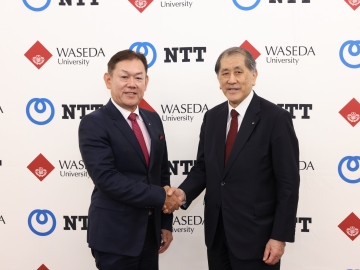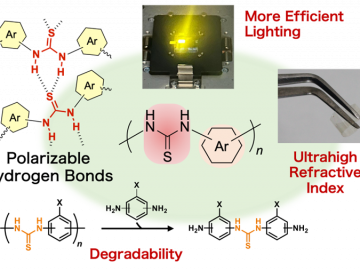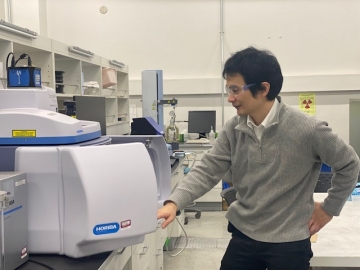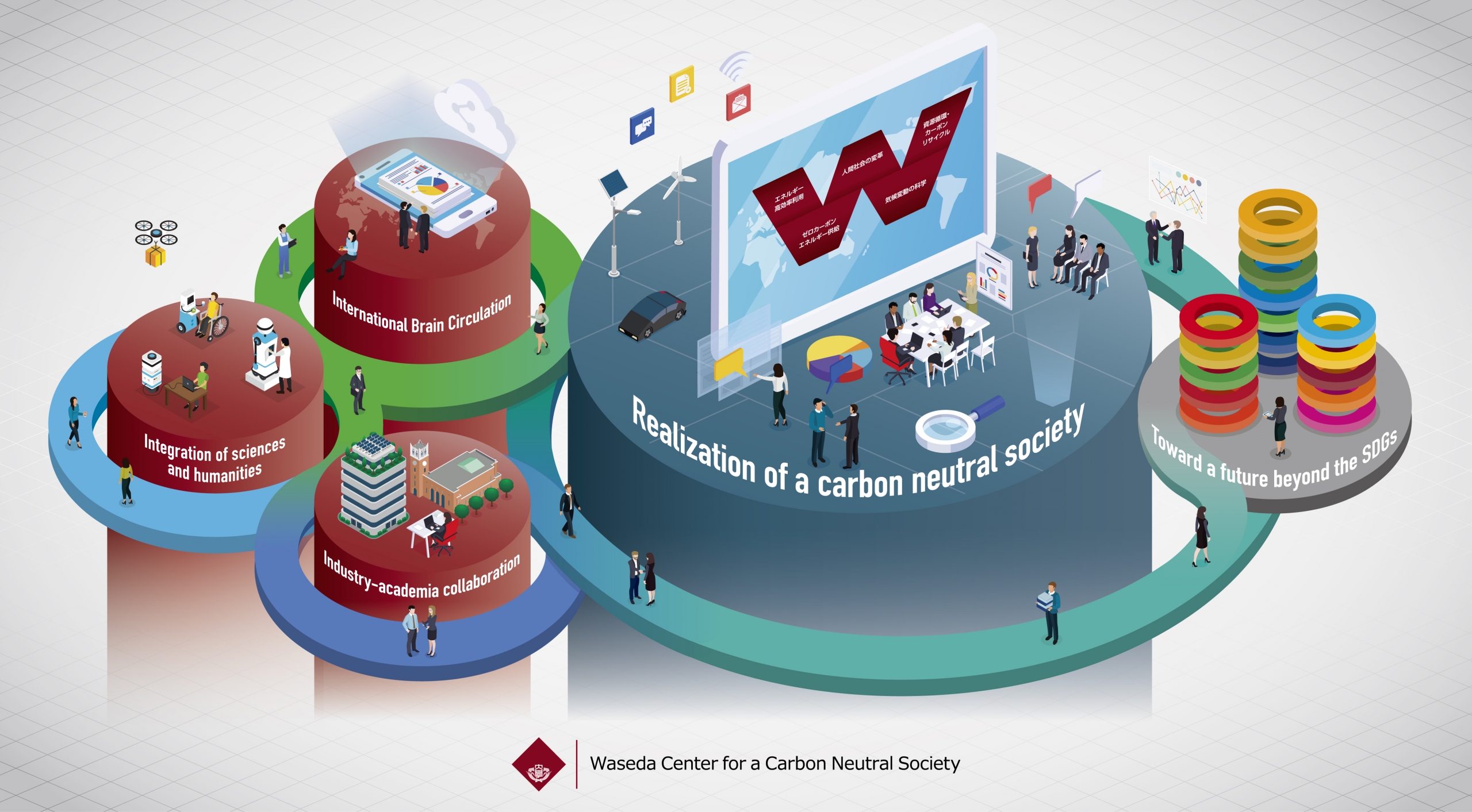Selected for the 2022 Moonshot Research and Development Program
Development of advanced enhanced rock weathering for efficiently capturing and fixing CO from the atmosphere
Key points of the announcement
◆To achieve carbon neutrality, enhanced rock weathering, in which natural rocks are crushed and spreaded to capture and fix CO2 in the atmosphere through the process of weathering (carbonation), has been attracting attention. However, the carbon accounting achieved by this technology has not been quantified sufficiently, and the actual amount of CO2 fixation has not been measured precisely.
◆The novel technology, “A-ERW” facilitates weathering in a way that is suitable for the land in the application area, enabling the achievement of both CDR (Carbon Dioxide Removal from the atmosphere and local resource circulation and co-benefits.
◆We aim to obtain and accumulate the mineralization rates of individual rocks and use them to build an information database to demonstrate life cycle assessment (LCA) of highly accurate carbon accounting both domestically and internationally and foster an international consensus on carbon accounting methodology that originated in Japan.

On September 26, 2022, a proposal by a group comprising Mitsubishi Heavy Industries, Ltd. (Yokohama City, Kanagawa Prefecture, President and CEO: Kenji Terasawa), Hokkaido University (Sapporo City, Hokkaido, President: Kiyohiro Houkin), and Kyoto Prefectural University (Kyoto, Kyoto Prefecture, President: Yasuhiro Tsukamoto) was selected for the project “Advanced enhanced rock weathering (A-ERW) technology actively combined with site characteristics” as part of New Energy Industrial Technology Development Organization (NEDO) Moonshot Research and Development Program*1, “Moonshot Goal 4: Realization of sustainable resource circulation for global environmental regeneration by 2050.” Professor Takao Nakagaki of Waseda University (Shinjuku, Tokyo, President: Aiji Tanaka) was appointed as the project manager (PM).
This project is focused on negative emission technologies (NETs)*2, which are essential for climate stabilization and carbon neutrality. The project will develop A-ERW to efficiently capture and fix CO2 from the atmosphere by taking advantage of the characteristics of the rocks in Japan and the sites where they are spread. Additionally, the data obtained through tests in actual environments will be used as a basis to build an information database for LCA*3 of carbon accounting. We aim to disseminate the data both locally and internationally and acquire international certification.
*A-ERW is an acronym for “advanced enhanced rock weathering,” but the “A” could also represent “accelerated,” “active,” “agro-industrial,” “advantageous,” “accurate,” or “accounting.”
(1) Knowledge obtained from previous research (research background)
Many countries, including Japan, have declared that they plan to achieve net zero greenhouse gas emissions by 2050–2060. To achieve this, even by 2050, there must be some way to avoid or offset the diffusion of anthropogenic CO2 into the atmosphere emitted from the use of liquid fuels for aircraft and heavy vehicles, which will be difficult to accomplish using only renewable energy, the incineration of nonrecyclable waste, and limestone used in the cement and iron and steel making. Furthermore, stabilizing the climate requires technologies for capturing and fixing already diffused CO2, and NETs have attracted attention as countermeasures against such emissions.
Among NETs, this project targets enhanced rock weathering (ERW)*4, which involves the capture and mineralization of atmospheric CO2 using natural rocks. ERW has mainly been used overseas and involves artificially crushing and pulverizing mafic rocks such as basalt and then spreading them on farmland to absorb CO2 through weathering (carbonation). However, the CO2 newly emitted owing to the application of ERW or the complex carbon balance, including the natural carbon cycle, has not yet been sufficiently quantified. The total fixed amount*5 and actual net fixed amount*6, which differ for each stratum and rock when ERW was used in Japan, were unknown.
Given this background, the Ministry of Economy, Trade, and Industry has set “Realization of sustainable resource circulation to recover the global environment by 2050” as Moonshot Goal 4 and has set the following goal for a cool earth: “Development of circulation technology on a pilot scale for reducing greenhouse gases that is also effective in terms of LCA by 2030.”
(2) New objectives to be realized in this project
Japan is a seismic and volcanic country located in the subduction zone of a plate. However, because of this, various types of natural rocks are outcropping and readily available in Japan. Therefore, we aim to develop an advanced “A-ERW” that efficiently captures and fixes CO2 from the atmosphere by taking advantage of the characteristics of the rocks in Japan and the sites where they are spread.
To date, the main processes of ERW are crushing basalt and spreading it on farmland. Therefore, it takes time for the atmospheric CO2 (including carbonate and bicarbonate ions) dissolved in rainwater to act on these spread rocks, and the net fixed amount of CO2 is small. Additionally, there is a scarcity of useful data that can be used as evidence to support carbon accounting. Therefore, in this project, ERW is re-considered as a functional breakdown of “physical specific surface area expansion (physical weathering)” and “CO2 mineralization by mass transport and chemical reaction,” and methods for accelerating each process are applied with as little additional energy as possible. Even when spreading on farmland, the actual fixed amount of CO2 can be increased by combining management methods and cultivation techniques tailored to the local soil characteristics. Additionally, advanced predictions based on test data and numerical computation methods are used as a basis to compile data, such as the CO2 mineralization potential and pre-treatment energy*7 for each type of rock, CO2 mineralization rate for each application, and CO2 mineralization rate after a specified period of time. Furthermore, we will verify the validity of the prediction model by developing efficient monitoring methods and tests in actual environments and collating the obtained data to develop a template for information database (Fig. 2) as evidence for LCA of carbon accounting.
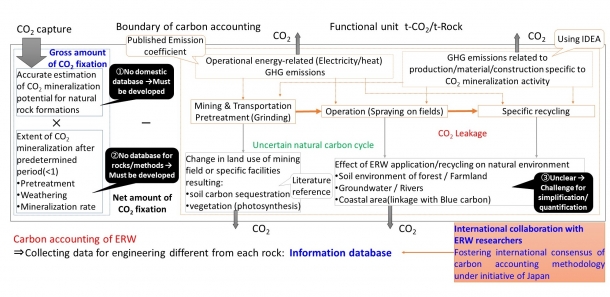
(3) Outcomes expected from this project
For A-ERW, Hokkaido was selected as the model area because of its abundant geological survey data. Rocks suitable for A-ERW obtained in each region will be efficiently crushed and weathered in a way that is suitable for the local region, resulting in NETs that remove CO2 from the atmosphere and introduce resource recycling and co-benefits to the local region.
For example, spreading on farmland can increase crop yield, provide nutrients, improve the physical properties of the soil, and increase organic carbon storage. Application on abandoned mine site and forest slopes can reduce CO2 emissions by reducing the use of lime as a neutralizer and preventing landslides, resulting in increased carbon sequestration. Furthermore, the Ca, Mg, K, and other elements in the spread rocks are expected to contribute to the alkalinization of coastal seawaters through rivers and improve CO2 retention in seawater. Moreover, rocks such as serpentinite, which are unsuitable for application on natural ground, can be used for the rapid mineralization*8 of CO2 in the atmosphere through industrial processes.
Additionally, by presenting an LCA of simple and highly accurate carbon accounting both domestically and internationally, we aim to achieve early social implementation of CO2 reduction credits while gaining international consensus.
(4) Roles of each organization
This project is the first attempt to clarify the LCA of carbon accounting for ERW under strong agro-industrial collaboration using the pre-treatment energy and CO2 mineralization potential of individual rock types as common data. The roles are divided as follows.
【Waseda University】
(Subcontractor) Sobue Clay Co., Ltd.
◆Research management, modeling of mineralization rate via gas-solid contactor, and development of the carbon accounting method
◆Evaluation of pre-treatment energy for each rock and creation of a mineralization potential database
【Mitsubishi Heavy Industries, Ltd.*】
(joint implementation) Mitsubishi Heavy Industries Power Environmental Solutions
* Former Mitsubishi Heavy Industries Engineering, Ltd. is merged on April 1st, 2023.
◆Field tests using mineralization greenhouse, conceptual design, and economic evaluation for scaling up
【Hokkaido University (Engineering)】
(Subcontractor) Japan Conservation Engineers Co., Ltd., Hokkaido Research Organization, Forestry and Forest Products Research Institute, QJ Science Co., Ltd.
◆Geological surveys using Hokkaido as a case study, business environment surveys, development of efficient monitoring methods, laboratory tests and modeling of application site-specific weathering, field tests in abandoned mine site and leached forest slopes, and development of carbon (including natural environment) accounting methods
【Kyoto Prefectural University, Hokkaido University (Agriculture)】
(Subcontractor) National Agriculture and Food Research Organization, University of Tokyo, Japan International Research Center for Agricultural Sciences, University of the Ryukyus
◆Laboratory tests and modeling of application on farmland for enhanced weathering, field tests on different soils in Hokkaido/Kanto/Nansei Islands, development of cultivation/soil management/monitoring methods, conceptual design of large-scale demonstration tests, soil carbon balance and development of carbon (including natural environment) accounting methods
(5) Comments by Project Manager (PM) Nakagaki
As an NET that is necessary for climate stabilization and the realization of carbon neutrality, ERW is a realistic solution from the perspective of CO2 reduction costs and total domestic potential, but difficulties have been encountered in carbon accounting. Additionally, passive natural processes alone progress slowly, and even artificial acceleration would be useless if the net fixed amount of CO2 significantly worsened owing to additional CO2 emissions. Fortunately, this project involves researchers and engineers who represent Japan in the relevant agro-industrial field, and we will tackle the challenge of solving these difficult problems with an all-Japanese team with specialized knowledge. If carbon accounting is clarified based on scientific evidence and an international consensus is obtained, it will be possible to commercialize this using credits. Together with the co-benefits of A-ERW, the goal is to enrich the region and contribute by fixing a gigaton (1 billion tons) of CO2.
(6) Research grant information
Grant name: NEDO Moonshot Research and Development Program Goal 4 “Realization of sustainable resource circulation for global environmental regeneration by 2050”
Research and development content: “CO2 absorption by carbonation: Technology for artificial enhancement of weathering by crushing and scattering rocks, such as basalt (enhanced weathering)”
Title: Advanced enhanced rock weathering (A-ERW) technology actively combined with site characteristics
Implementation period: Three years, from FY2022 to FY2024
(Reference) Five new projects selected for NEDO Moonshot Research and Development Program
–Starting to identify technologies for artificial acceleration of natural CO2 absorption capacity–
https://www.nedo.go.jp/news/press/AA5_101573.html
(7) Participation (joint research) core/researcher information
Professor Takao Nakagaki, Department of Modern Mechanical Engineering, School of Creative Science and Engineering, Waseda University
Professor Tsutomu Sato, Faculty of Engineering; Professor Takuro Shinano and Professor Yo Toma, Faculty of Agriculture, Hokkaido University
Yoshiaki Arakawa, Mitsubishi Heavy Industries, Ltd. (project contact)
Associate Professor Atsushi Nakao, Graduate School of Life and Environmental Sciences, Kyoto Prefectural University
(8) Glossary
*1: Moonshot Research and Development Program
This new program is developed to create disruptive innovations in Japan by promoting challenging research and development (Moonshots) based on bolder ideas that are not simply extensions of conventional technology. Research and development (R&D) are promoted through collaboration between the Cabinet Secretariat, Cabinet Office, Ministry of Education, Culture, Sports, Science and Technology, Ministry of Health, Labor and Welfare, Ministry of Agriculture, Forestry and Fisheries, and Ministry of Economy, Trade, and Industry. For the seven Moonshot Goals established by the Council for Science, Technology, and Innovation, the Project Manager, under the Program Director, who is in charge of the overall research and development for each goal, formulates scenarios leading to the achievement of the Moonshot Goal and the realization of the R&D concept, designs the R&D project, builds the R&D system, and manages the R&D project implementation.
*2: Negative emission technologies
These are technologies that contribute to the removal of atmospheric CO2 (carbon dioxide removal, CDR) by capturing, absorbing, storing, and fixing CO2 in the atmosphere. These technologies and processes accelerate the process of natural CO2 absorption and fixation by adding an artificial process.
*3: LCA of carbon accounting
This is used for determining the evaluation boundary and the accurate calculation of the carbon balance of the entire A-ERW as a life cycle assessment. In enhanced weathering, the energy required for mining, crushing, and spreading rocks, as well as the CO2 emissions from the production of the equipment, should be subtracted from the total amount of CO2 fixed into rocks. It is also necessary to include not only plant respiration and photosynthesis but also changes in organic matter caused by microorganisms in the soil, atmospheric emissions of greenhouse gases with high global warming potential (GWP), such as methane and nitrous oxide, and increases in CO2 absorption due to the alkalinization of inshore areas by the mineral outflow from rocks through groundwater and rivers.
*4: Enhanced rock weathering
This is a process that crushes natural rocks to expand their specific surface area to artificially facilitate the natural process of mineralizing and semi-permanently fixing CO2 in the atmosphere as carbonates using the minerals contained in the rocks, such as calcium (Ca) and magnesium (Mg).
*5: Total fixed amount
This is expressed as the product of the CO2 mineralization potential (the theoretical maximum amount after an infinite period of time) and the CO2 mineralization rate after a specified period of time, such as one year, with different values for each rock or stratum.
*6: Net fixed amount
This is the amount determined by subtracting from the total fixed amount of CO2 emitted from ERW activities that can be calculated in terms of engineering, greenhouse gases including CO2 from changes in land use, and changes in the soil carbon balance that can be determined in terms of agriculture, etc.
*7: Pretreatment energy
This is the energy required for processing before application, such as the power required to excavate and transport natural rocks with heavy machinery and to crush and pulverize them to a particle size (µm) suitable for enhanced weathering.
*8: Rapid industrial mineralization of CO2 in the atmosphere
Previously published by Corey A. Myers and Takao Nakagaki, “Direct mineralization of atmospheric CO2 using natural rocks in Japan,” in Environmental Research Letters, Volume 15, Number 12, 2020. The article was featured in Box 3-1 in the carbon mineralization roadmap published by the ICEF in November 2021.


